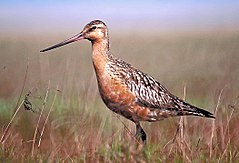Rycyki
Wygląd
| Limosinae | |||
| G.R. Gray, 1841[1] | |||
 Przedstawiciel podrodziny – szlamnik zwyczajny (L. lapponica) | |||
| Systematyka | |||
| Domena | |||
|---|---|---|---|
| Królestwo | |||
| Typ | |||
| Podtyp | |||
| Gromada | |||
| Podgromada | |||
| Infragromada | |||
| Rząd | |||
| Podrząd | |||
| Parvordo | |||
| Nadrodzina | |||
| Rodzina | |||
| Podrodzina |
rycyki | ||
| Typ nomenklatoryczny | |||
|
Scolopax limosa Linnaeus, 1758 | |||
| Synonimy | |||
| |||
| Rodzaje i Gatunki | |||
| |||
Rycyki[11] (Limosinae) – monotypowa podrodzina ptaków z rodziny bekasowatych (Scolopacidae).
Zasięg występowania
[edytuj | edytuj kod]Podrodzina obejmuje gatunki w sezonie lęgowym występujące w Eurazji i Ameryce Północnej, zimą także w Afryce, Australii, Oceanii i Ameryce Południowej[12].
Morfologia
[edytuj | edytuj kod]Długość ciała 36–48 cm, rozpiętość skrzydeł 60–82 cm; masa ciała samic 246–630 g, samców 190–440 g[12].
Systematyka
[edytuj | edytuj kod]Etymologia
[edytuj | edytuj kod]- Limosa: epitet gatunkowy Scolopax limosa Linnaeus, 1758; łac. limosus „zmącić”, od limus, limi „błoto, szlam”[13].
- Rusticola: łac. rusticula „nieznany ptak łowny”[13]. Gatunek typowy: Rusticula grutto Houttuyn, 1770 (= Scolopax limosa Linnaeus, 1758).
- Limicula: łac. limicola „mieszkaniec błota”, od limus, limi „błoto, szlam”; -cola „mieszkaniec”, od colere „mieszkać”[13]. Gatunek typowy: Scolopax limosa Linnaeus, 1758.
- Gambetta: bolońska (włoska) nazwa Gambetta dla jakiegoś rodzaju brodźca (za Aldrovandim 1599 rok), od łac. gamba noga, być może od gr. καμπη kampē „pochylać się”[13]. Gatunek typowy: Scolopax limosa Linnaeus, 1758.
- Fedoa: zlatynizowana forma od angielskiego słowa fedoa oznaczającego rycyka[13]. Gatunek typowy: Scolopax fedoa Linnaeus, 1758.
- Actites: gr. ακτιτης aktitēs „mieszkaniec wybrzeża”, od ακτη aktē, ακτης aktēs „wybrzeże”; ιζω izō „siedzieć”[13]. Gatunek typowy: Scolopax limosa Linnaeus, 1758.
- Aegocephalus: gr. αιγοκεφαλος aigokephalos „nieznany ptak”, identyfikowany przez niektórych autorów z puchaczem, od αιξ aix, αιγος aigos „koza”; κεφαλη kephalē „głowa”[13]. Gatunek typowy: Scolopax limosa Linnaeus, 1758.
- Vetola: lokalna wenecka nazwa Vetola dla rycyka[13]. Gatunek typowy: Scolopax lapponica Linnaeus, 1758.
Podział systematyczny
[edytuj | edytuj kod]Do podrodziny należy jeden rodzaj z następującymi gatunkami[11]:
- Limosa lapponica (Linnaeus, 1758) – szlamnik
- Limosa limosa (Linnaeus, 1758) – rycyk
- Limosa haemastica (Linnaeus, 1758) – szlamnik amerykański
- Limosa fedoa (Linnaeus, 1758) – szlamnik duży
Przypisy
[edytuj | edytuj kod]- ↑ G.R. Gray: A list of the genera of birds: with their synonyma an indication of the typical species of each genus. Wyd. 2. London: R. and J.E. Taylor, 1841, s. 88. (ang.).
- ↑ M. Houttuyn: Korte inhoud van’t eerste deel van deel van dit vogelen-werk. W: C. Nozeman: Nederlandsche vogelen; vogens hunne huishouding, aert en eigenschappen beschreeven. T. 1. Amsterdam: J.C. Sepp, 1770, s. 1. (niderl.).
- ↑ L.J.P. Vieillot: Analyse d’une nouvelle ornithologie élémentaire. Paris: Deteville, libraire, rue Hautefeuille, 1816, s. 56. (fr.).
- ↑ C.L. Koch: System der baierischen Zoologie: zum Gebrauch als Taschenbuch. Nürnberg: in Kommission bei der Steinischen Buchhandlung, 1816, s. 307. (niem.).
- ↑ J.F. Stephens: Fedoa. Godwit. W: G. Shaw: General zoology, or Systematic natural history. T. 12: Aves. Cz. 1. London: Printed for G. Kearsley, 1824, s. 70. (ang.).
- ↑ G.J. Billberg: Synopsis Faunae Scandinaviae. T. 1. Cz. 2: Aves. Holmiae: Ex officina typogr. Caroli Deleen, 1828, s. 153. (łac.).
- ↑ G.R. Gray: A list of the genera of birds: with their synonyma an indication of the typical species of each genus. London: R. and J.E. Taylor, 1840, s. 68. (ang.).
- ↑ G.M. Mathews: The Birds of Australia. Cz. 3. London: H.F. & G. Witherby, 1913–1914, s. 191. (ang.).
- ↑ Limosa, [w:] Integrated Taxonomic Information System [dostęp 2013-02-10] (ang.).
- ↑ M.J. Brisson: Ornithologie, ou, Méthode contenant la division des oiseaux en ordres, sections, genres, especes & leurs variétés, a laquelle on a joint une description exacte de chaque espece, avec les citations des auteurs qui en ont traité, les noms quils leur ont donnés, ceux que leur ont donnés les différentes nations, & les noms vulgaires. T. 5. Parisiis: Ad Ripam Augustinorum, apud Cl. Joannem-Baptistam Bauche, bibliopolam, ad Insigne S. Genovesae, & S. Joannis in Deserto, 1760, s. 261. (fr. • łac.).
- ↑ a b Systematyka i nazwy polskie za: P. Mielczarek & M. Kuziemko: Podrodzina: Limosinae Gray,GR, 1841 - rycyki (Wersja: 2021-10-03). [w:] Kompletna lista ptaków świata [on-line]. Instytut Nauk o Środowisku Uniwersytetu Jagiellońskiego. [dostęp 2022-11-02].
- ↑ a b T. Piersma, J. van Gils & P. Wiersma: Family Scolopacidae (Sandpipers, Snipes and Phalaropes). W: J. del Hoyo, A. Elliott & J. Sargatal: Handbook of the Birds of the World. Cz. 3: Hoatzin to Auks. Barcelona: Lynx Edicions, 1996, s. 501–502. ISBN 84-87334-20-2. (ang.).
- ↑ a b c d e f g h Etymologia za: The Key to Scientific Names, J.A. Jobling (red.), [w:] Birds of the World, S.M. Billerman et al. (red.), Cornell Lab of Ornithology, Ithaca (ang.).